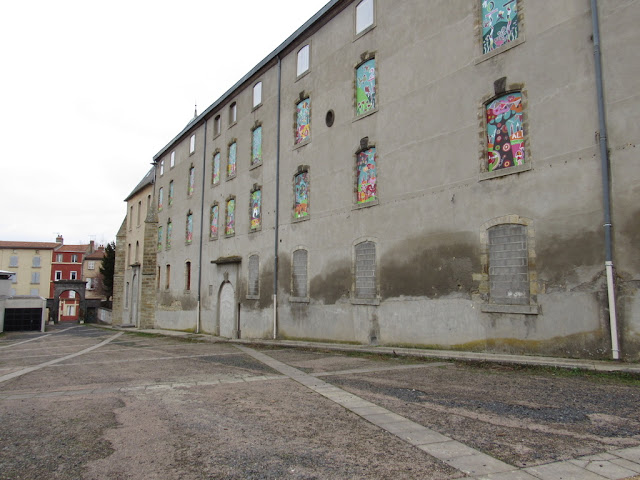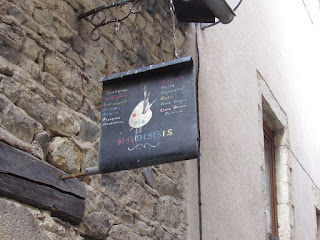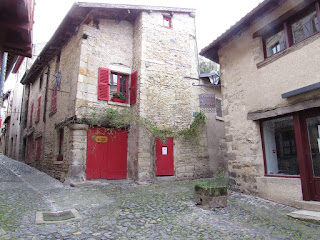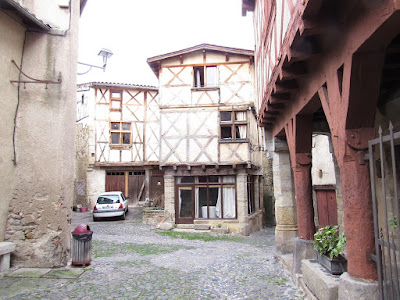Medievalists were crazy about symbols, and they spared no expense or effort in displaying them on their churches, buildings, and homes. In Le Puy-en-Velay, there are certain symbols derived from alchemy that are everywhere etched in stone--if you know where to look.
These symbols, called
the "language of the birds," were combined with rebuses, word games,
anagrams, analogies, and correspondences so that followers could
recognize each other.
Alchemy came to Europe starting in the 8th century and to France in the 12th century, courtesy of the Arabs in Spain. Its initial purpose was to transform base metals into pure metals. However, the alchemical processes went beyond the physical properties of metals when its practitioners sought healing remedies for illnesses. Alchemy later expressed the qualities of spiritual transformation, which is a much more interesting concept. Swiss psychiatrist and writer Carl Jung was particularly fond of alchemical symbolism in his work on the unconscious mind.
"The goal of alchemy is to obtain the Philosopher's Stone, which heals everything," said Christian Cheynel, a local Le Puy man who has conducted tours on the alchemical symbols of the city's architecture for the past 15 years. In other words, it is "a force that would allow healing", which is the signature of the alchemist's "Great Work".
The exterior walls of the Cathedral of Notre Dame--Le Puy, for example, include a number of alchemical signs and symbols. For example, at the top of the portal of the main entrance is the chrism, a symbol of early Christianity, framed by two dolphins. The chrism symbolizes the crossing of the four sacred meridians (north, south, east, west). The two dolphins represent the feminine (mercury) and masculine (sulphur) principles, which form the Alchemical Marriage.*
* The Alchemical Marriage of mercury (female) and sulfur (male)
is the union of duality and the most revered and possibly powerful
union. It is the perfect conjunction, intimate bonding of duality and
signifies the pure, deep harmony which occurs whenever the masculine and
feminine elements of nature combines into One.
The
chrism is derived from the Greek letters X and P which means
"to lead, to command, to be in the head." It refers to the image of
Christ who represents the first head or founder of the nascent Christian
church. When it is engraved in a circle, it projects an image of unity and
divine perfection. Besides being the symbol of the Christian religion,
the monogram of Christ is also a symbol of protection. This monogram is often found on the walls of Christian religious buildings, mosaics, various objects, and jewelry, according to Tendence Agency.
Louis Charpentier (1905-1979), a journalist and researcher on sacred geometry, posits that the chrism is the signature of the "compagnons passants," men who built architectural masterpieces like the Cathedral. They were the "children of Maître Jacques," itinerant stone builders who moved throughout western Europe building menhirs (tall, vertically placed standing stones) and dolmens (table-like structures comprising a large slab laid horizontally on two smaller stone supports), temples, and sacred Christian buildings in the "Gallo-Roman" style.
 The original "Maître Jacques" oversaw
the construction of the Temple at Jerusalem around 900 BCE on behalf of King Solomon. His descendants were the builders and peasants identified as "the people of stone and earth" who covered the West with
megaliths and dolmens. Jacques became the generic name of these builders and peasants (Tarot History).
The original "Maître Jacques" oversaw
the construction of the Temple at Jerusalem around 900 BCE on behalf of King Solomon. His descendants were the builders and peasants identified as "the people of stone and earth" who covered the West with
megaliths and dolmens. Jacques became the generic name of these builders and peasants (Tarot History).
 Here are several other alchemical symbols found on the Cathedral and in the city of Le Puy.
Here are several other alchemical symbols found on the Cathedral and in the city of Le Puy.
The top of the Cathedral's facade features black, white, and red stones. These colors signify the alchemical process of transformation that moves toward purification and healing.
The same colors are present in the Black Madonna, who is enshrined in
the Cathedral's sanctuary. For alchemists, black represents the noble base
material that will give birth to the "child of the sun" or the "red
work." Red is the symbol of transformation.


The Cathedral's West Porch, which is accessible by the 134 exterior steps facing the Rue des Tables, is decorated with a tetramorph (a symbolic arrangement of four differing elements in one unit) made up of four iconographic sculptures symbolizing transformation:
the bull, the eagle, the winged man, and the lion. It is another
alchemical signature of the Cathedral builders that illustrates
transformation.
"The bull represents the apprentice who leaves
his parents," said Cheynel. "If he succeeds, he becomes a companion builder (eagle), and then an
accomplished companion (winged man). After being purified by fire
(lion),
he becomes an accomplished master."
In
the center of the vault is a fifth element: the alchemical fire or the
energy of life as represented by the the Blessed Virgin Mary carrying
the baby Jesus in her arms.
 The Square of Saturn is another alchemical symbol that was deliberately
placed on the porch landing atop the 134-step ascent to the Cathedral. None of the other stone landings is black, which distinguishes this stone.
The Square of Saturn is another alchemical symbol that was deliberately
placed on the porch landing atop the 134-step ascent to the Cathedral. None of the other stone landings is black, which distinguishes this stone.
* The Square of Saturn is a magic square consisting of 9 smaller squares, which when added up horizontally, vertically or diagonally total 15. It is often used as a talisman where the qualities of the planet Saturn are required.
 The Gilded Porch on the east side of the Cathedral is rich in symbols, too. The papal door, used by
the companion builders as an entrance, is its
quintessence.
The Gilded Porch on the east side of the Cathedral is rich in symbols, too. The papal door, used by
the companion builders as an entrance, is its
quintessence.
* Quintessence is the fifth and highest element in ancient and medieval philosophy that permeates all nature and is the substance composing the celestial bodies. It is the essence of a thing in its purest and most concentrated form.
 On one of the pillars, a
sculpture shows a man, mouth open, between two dogs with their backs to each
other. This is the symbol of an accomplished companion builder.
On one of the pillars, a
sculpture shows a man, mouth open, between two dogs with their backs to each
other. This is the symbol of an accomplished companion builder.
Two ouroboros (snakes that bite their tails and form a circle), known as the oldest and most important allegorical symbol in alchemy, represent the eternal cycle of birth, death, and rebirth. The fundamental message of the ouroboros is the changing of one thing into another, ultimately yielding the principle that “All is One.” It is a symbol for Mercurius and the union of opposites. On a higher level of the "Great Work", the ouroboros represents the indistinguishable and eternal flow of sulphur (masculine) and mercury (feminine) into one another. The permanent fusion of these two elements creates the Philosopher’s Stone (Occult World).

another view of the 2 ouroboros
A crowned mermaid holds two tails in her hands. Mermaids embody the sacred feminine and symbolize awareness and insight. This symbol signifies the crossing of two streams as the mermaid combines two opposing natures. Her crown shows that she has achieved purification and that she has mastered both energies.
The Alchemical Marriage is represented by three birds.
An upside down owl protects two eagles under its wings. The eagles turn their backs from one another even as they try to look at each other.“This owl represents humanity," said Cheynel. "He is in an uncomfortable position because he is embarrassed about the matter. But in him there is the promise of revelation.”
It is important to note that the Cathedral was built on Mount Anis, the highest point in the city. This was no accident. Mount Anis has always been a place of worship going back at least to 2000 BCE because it has been recognized as a place of high energy. There is some evidence that spiritual worship on Mount Anis goes back 7,000 years.
First of all, the geology of the area is composed of volcanic rock, which is typically magnetic, said Cheynel. This rock generates a lot of energy, which comes from an energy vortex.
"An energy vortex is a specific location on Earth which acts as a swirling center of energy, containing more earthly energy than any normal place would," according to Kristin, a popular travel writer on her blog. "One common belief in regard to energy vortexes is that they exist at the intersections of ley lines or the random lines of natural energy that make up the Earth’s electromagnetic field.
Cheynel adds that energy coming from the vortex is a "cosmo-telluric" node (sky and Earth) that intersects to release and capture energy just like a transmitter and a receiver of information.
“The cathedral acts as a big sounding board for everyone to enjoy this energy," says Cheynel .
 Thus, it is significant that the ancient
Fever Stone still holds a place in the Cathedral. This 10'x4' black stone lies to the left of the main altar. Legend has it
that a sick widow who lay on the stone was miraculously healed. Visitors
to the Cathedral regularly lie on the stone or touch it.
Thus, it is significant that the ancient
Fever Stone still holds a place in the Cathedral. This 10'x4' black stone lies to the left of the main altar. Legend has it
that a sick widow who lay on the stone was miraculously healed. Visitors
to the Cathedral regularly lie on the stone or touch it.
Stone played a large role in medieval alchemy because of its
healing properties. Lithotherapy emerged as a healing practice; the
Lapidaries or texts recorded this knowledge. Certain stones and crystals
were thought to attract the favor of the gods or at least to bring out
the virtues the stones held in an effort to heal wounds, sickness, and
discomforts like headaches. People would sometimes wear the stones as
jewelry or rub the stones on their wounds for relief. Stones
were also linked to particular saints, classes of angels, and other areas of
Christianity. Hildegarde de Bingen (1098-1179), a nun renowned for
healing science, worked with magnetic stones, magnets, and venom from
poisonous reptiles.
In the 15th century, alchemical symbols began to be carved into the stone facades of several houses in Le Puy, says Cheynel.
On Rue de Prat-du-Loup, there is a she-wolf carved in stone. This animal symbolizes the liquid coagulation phase of the great work: the Alchemical Marriage of mercury and sulfur.
On Rue de Rochetaillade, a dolphin is carved above the door of the Residence of Lake Fugères. It symbolizes the feminine principle of matter and volatile mercury.
On Rue Adhémard-de-Monteil, five coats of arms are represented on the facade of one house. Two profiles (female and male), the IHS Christogram in a padlock and a heart referring to the Crusades. It is a rebus that speaks to foreign alchemists on pilgrimage to tell them that in this place there is a brother to welcome them.
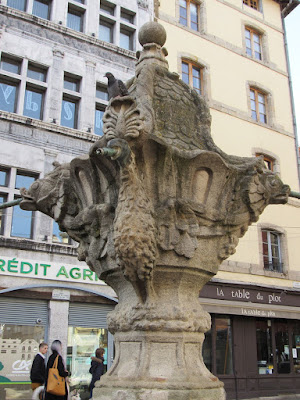 The Bidoire Fountain in Place du Plot dates from the 13th century. The pine cone on its top (symbol of quintessence) is placed on a dolphin rhombus. The eagle and the dolphin (feminine
principles of matter) make water (long life) gush out. Below, the lions
symbolize the raw mineral matter from the beginning of the work called the
Subject of the Sages, which were transmuted by alchemical fire (the wheel of fire) in order to give life to matter.
The Bidoire Fountain in Place du Plot dates from the 13th century. The pine cone on its top (symbol of quintessence) is placed on a dolphin rhombus. The eagle and the dolphin (feminine
principles of matter) make water (long life) gush out. Below, the lions
symbolize the raw mineral matter from the beginning of the work called the
Subject of the Sages, which were transmuted by alchemical fire (the wheel of fire) in order to give life to matter.
The Charles Crozatier Fountain in Place du Breuil just outside the old city has at its top a black, uncrowned virgin, which represents the raw material. The water feature is built on a vortex. The dolphin represents mercury and sulfur that will be purified in the vessels for transmutation.


Alchemy sought to bring together all forms of knowledge including numerology, mathematics, astronomy, and astrology. Alchemists were sometimes regarded as saints, magi, or sorcerers who had the power of healing. They were also the masters in charge of the "companion builders," those who erected the great cathedrals. They taught alchemy by placing symbols on the facades of monuments and later on the facades of their homes. Le Puy has always been known as a sacred place, and the medieval alchemists made sure that the spiritual qualities of transformation were recognized in their language, the "language of the birds."
Sources
L'Éveil, December 31, 2020
https://www.leveil.fr/puy-en-velay-43000/loisirs/le-puy-en-velay-creuset-du-grand-uvre_13897982/
L'Éveil, October 22, 2018






















